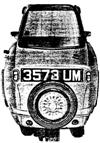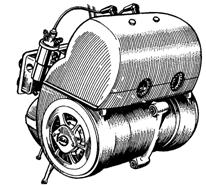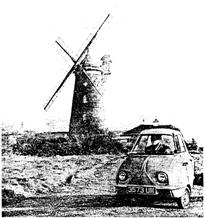Mk3 Scootacar
The Mk3 Scootacar was introduced in 1962 with a price tag of £377. The Mk2 Scootacar had been introduced in 1960 to compete against the Mini and the Mk3 yet a further attempt with a more powerful engine but unfortunately the Scootacar’s days were numbered. Eventually the Mini and other economy cars killed off the Scootacar along with many other micro cars.
As far as I am aware the exact production figures for the Mk3 were never published but what I am sure about is that only a small number of cars came off the production line, probably less than 20. Survival rate however has been quite good, with some 13 cars known to the Scootacar Register.
However, being the rarest model of the three types of Scootacar with only a small production run has not really enhanced its value. Most owners or prospective owners of Scootacars seem to prefer the body shape of the Mk1 and so I generally value all three types the same.

Externally the Mk3 Scootacar was the same as the Mk2 except for the rear of the car which had two holes in the bodywork under the rear bumper for air intake.
Obviously the main difference between the Mk2 and the Mk3 was the power unit. The Mk3 was fitted with a Villiers 3T twin cylinder; 324cc fan cooled two stroke engine with a four speed gear box, incorporating Electric Starter/ Generator for forward and reverse running.
 Villiers had introduced the 2T in 1956. The vertical twin had a bore and stroke of 50mm and 63.5 giving 249cc. Each barrel had its own crankshaft separated by a central disc in the crankcase holding a central bearing with a roller bearing on the magneto side and a ball bearing on the sprocket side. The small ends were made of steel backed with brass bushes. Alloy heads were fitted to cast iron cylinders.
Villiers had introduced the 2T in 1956. The vertical twin had a bore and stroke of 50mm and 63.5 giving 249cc. Each barrel had its own crankshaft separated by a central disc in the crankcase holding a central bearing with a roller bearing on the magneto side and a ball bearing on the sprocket side. The small ends were made of steel backed with brass bushes. Alloy heads were fitted to cast iron cylinders.
The 3T was introduced in 1957 with the bore widened to 57mm to give
the 324cc. (2 x 162cc) and therefore an ideal replacement for the 197cc
engine which had been fitted to the Mk11.
There were other minor differences between the Mk2 and Mk3 but most
associated with the engine fitment, having a different cradle arrangement
and of course a different Speedo !
Not very much was written about the Mk3 Scootacar but those who tested it thoroughly enjoyed it. There are a couple of well known road tests which used the same test car “3573 UM” :
 MOTOR CYCLING December 7th 1961
MOTOR CYCLING December 7th 1961
SMALL CAR January 1963
Scootacars Limited used the same sales brochure as that produced for
the Mk2 and just attached a sticker with the additional information
relating to the Mk3, that being the Engine, Transmission and Battery.
The Maximum speed was quoted as being around 68mph and was
therefore among the fastest of the small capacity three wheelers.
I am currently restoring a Mk3 and have been advised on more
than one occasion by Henry Brown, the designer of the car, that it
is over powered and can be quite dangerous to drive !
Should you be able to help out, I would like to know the location of
the windmill featured in the “Motor Cycling” road test of 1961.
Can you help ?
Techincal information about the Mk3 Scootacar
This information has been displayed to show the differences against the Mk1 and Mk2.
| Scootacar model | Mk1 | Mk2 | Mk3 |
|---|---|---|---|
| Scootacar name | Standard | De-Luxe (Low Line) | De-Luxe twin (Low Line) |
| Approx production | 750 | 200 | 20 |
| Aprox % of total | 75% | 22% | 3% |
| Approx No of cars known | 160 | 35 | 13 |
| Approx % each car known | 21% | 18% | 65% |
| Start of manufacture | 1957 | 1960 | 1961 |
| Finish of manufacture | 1964 | 1965 | 1965 |
| Length | 7ft 3" | 7ft 11" | 7ft 11" |
| Width | 4ft 4" | 4ft 4" | 4ft 4" |
| Height | 4ft 11.5" | 4ft 9.5" | 4ft 9.5" |
| Unlaiden Weight | 4.5cwt | 5.25cwt | 6.0cwt |
| Wheelbase | 54" | 54" | 53" |
| Track | 45" | 54" | 54" |
| Ground clearance | 5" | Not known | Not known |
| Standard colours | red, blue, ivory | Silver, grey-red, blue | silver grey-red, blue |
| Approx percentage | 60%,20%20% | 90% 10% | 90% 10% |
| Engine | Villiers single | Villiers single @15 degrees | Villiers twin |
| Bore | 59mm | 59mm | 57mm |
| Stroke | 72mm | 72mm | 63.5mm |
| cc | 197cc | 197cc | 324cc |
| Compression ratio | 7.25:1 | 7.25:1 | 7.25:1 |
| Max power output | 8.4 BHP | 8.4 BHP | 16.5 BHP |
| Engine spoket | 20 teeth x3/8 pitch | 20 teeth x3/8 pitch | 25 teeth x3/8 pitch |
| Max power | 4000rpm | 4000rpm | 5000rpm |
| Spark plug/s | HH14 | HH14 | HH14 |
| Spark plug/s gap | 0.18-.025" | 0.18-.025" | 0.18-.025" |
| Battery neg earth | 12v 18 amp hr | 12v 18 amp hr | 12v 32 amp hr |
| Contact breaker gaps | 0.20-0.22 | 0.20-0.22 | 0.20-0.22 |
| Inigition timing | 11/64 before tdc | 11/64 before tdc | 3/16 before tdc |
| Clutch | Villier 4 plate | Villier 4 plate | Villiers 4 plate |
| Chain | 0.375 x 0.225 x 0.250 | 0.375 x 0.225 x 0.250 | 0.375 x 0.225 x 0.250 |
| Pitches | Unknown | 58 pitches | 62 pitches |
| Final drive ratio | 4.65:1 | 4.65:1 | 3.92:1 |
| Tyres Mitchelin | 400x8" | 400x8" | 400x8" |
| Front tyre pressure | 18lbs/sq inch | 18lbs/sq inch | 22lbs/sq inch |
| Rear tyre pressure | 32lbs/sq inch | 28lbs/sq inch | 40lbs/sq inch |
| Brakes front lockheed | Hydraulic | Hydraulic | Hydraulic |
| Brake rear (Hand brake) | Cable | Cable | Cable |
| Max Speed | 50mph | 49mph | 68mph |
| Fuel Consumption @ 30mph | 80mpg | 80mpg | 96mpg |
| Fuel capacity | 2.75 gallons | 2.55 gallons | 2.55 gallons |
| Lubrication SAE30 | 20:1 | 20:1 | 20:1 |
| Option | Spare wheel/tyre | Fitted as standard | Fitted as standard |
| Option | Reversable engine | Fitted as standard | Fitted as standard |